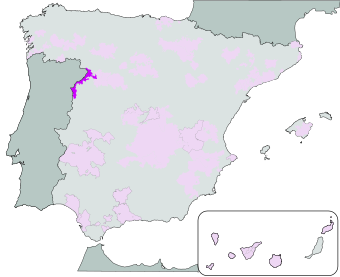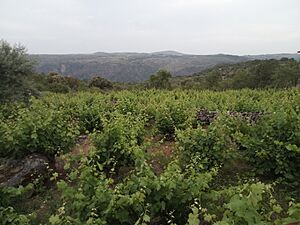Arribes (wine) facts for kids
| Wine region | |

|
|
| Official name | D.O. Arribes |
|---|---|
| Type | Denominación de Origen Protegida (DOP) |
| Year established | 2005 |
| Country | Spain |
| Size of planted vineyards | 245 hectares (605 acres) |
| No. of wineries | 17 |
| Wine produced | 697 hectolitres |
| Comments | Data for 2016 / 2017 |
Arribes is a special area in Spain where unique wines are made. It has a "Protected Designation of Origin" (DOP) status. This means its wines are known for their quality and come from this specific region.
The Arribes area is located in the provinces of Zamora and Salamanca. It sits along the border with Portugal, right next to the Duero River. In 2002, this beautiful area became a Natural Park. It is called the Parque Natural de Arribes del Duero.
Contents
History of Arribes Wines
People have been making wine in the Arribes region for a very long time. There are two main ideas about how winemaking started here.
Who Started Winemaking?
One idea is that the ancient Romans brought grape growing and winemaking to Arribes. They were known for spreading their farming methods.
Another idea suggests that the Phoenicians might have started it even earlier. They were skilled sailors and traders. They could have used their ships on the Duero River to reach this area.
Becoming a Protected Region
In 1998, the Arribes area was first recognized as a "Vino de la Tierra." This means "Wine of the Land." It was a step towards official recognition.
Then, on July 27, 2005, Arribes received a higher status. It became a "Denominación de Origen" (DO). This is a special label that guarantees the quality and origin of the wine.
What Does "Arribes" Mean?
The name "Arribes" comes from an old Latin phrase, ad ripam. This phrase means "on the banks." It refers to the vineyards being located right on the banks of the Duero River.
Climate and Weather
The Arribes region has a Mediterranean climate. This means it generally has warm, dry summers and mild winters. However, it also gets some influence from the Atlantic Ocean.
Rainfall is spread out throughout the year. Summers are usually warm and dry, which is good for grape ripening. Winters are not too cold, helping the vines rest.
Soils of the Vineyards
The soil in Arribes is very important for the grapes. It is not very deep, meaning the roots don't go far down. The soil is mostly sandy.
Soil Composition
You can find loose granite and quartz pebbles in the soil. There are also many rocky areas. The soil generally does not have a lot of organic matter.
How Soil Helps Grapes
The soil underneath (called the subsoil) helps water drain away well. This prevents the grapevines from getting too much water. The subsoil also helps control the temperature. Slate is found in the subsoil. It soaks up heat during the day and slowly releases it at night. This helps keep the vines warm when it gets cool.
Grape Varieties Grown
The Arribes region grows specific types of grapes. These grapes are chosen for their quality and how well they grow in the local climate.
Red Grape Varieties
The main red grapes allowed are:
- Tempranillo (also known as Tinta Serrana or Tinto Madrid)
- Juan García
- Rufete
- Garnacha Tinta
- Mencía
- Bruñal / Albarín Tinto
White Grape Varieties
The main white grapes allowed are:
- Malvasía Castellana / Doña Blanca
- Albillo Mayor
- Albillo Real
- Verdejo
Types of Wines Produced
Wineries in Arribes make different kinds of wine. Each type has its own special characteristics.
Red Wines
- Tinto joven (young reds): These wines are made mostly from Juan García, Rufete, and Tempranillo grapes. They are meant to be enjoyed young.
- Tinto Crianza (oak aged reds): These red wines spend at least 6 months in oak barrels. After that, they age for another 18 months in bottles before being sold. This aging process gives them a richer flavor.
Rosé and White Wines
- Rosado (rosé): These pink wines must be made with at least 60% of Juan García, Rufete, and Tempranillo grapes.
- Blanco (white): White wines from Arribes must contain at least 60% Malvasía grapes.
See also
 In Spanish: Arribes (vino) para niños
In Spanish: Arribes (vino) para niños


